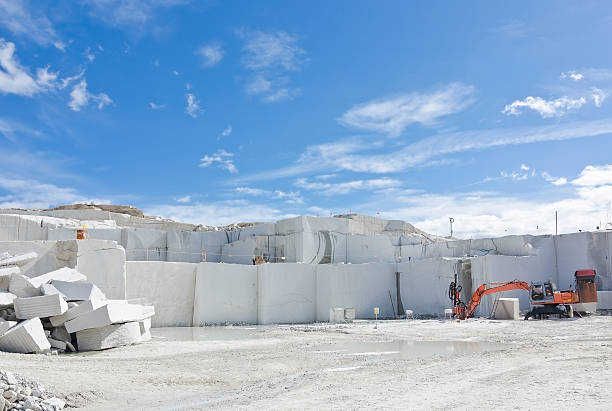Checking Out Granite Quarries in South Africa Sector: From Quarry to Masterpiece
Checking Out Granite Quarries in South Africa Sector: From Quarry to Masterpiece
Blog Article
Introducing the Mysteries of Granite Quarrying: Where Stamina and Sophistication Meet
The globe of granite quarrying is a realm where the raw toughness of nature merges with human creativity to produce frameworks that stand the test of time with an air of beauty. From the depths of quarries to the precise sprucing up in workshops, the process of transforming granite right into architectural marvels is a complex dancing of practice and technology. As we peer into the depths of this old craft, we begin to discover the hidden complexities that form the really significance of our built setting.
The Origins of Granite Quarrying
In the record of building background, the origins of granite quarrying are shrouded in a tapestry of ancient workmanship and geological wonders. Dating back to old Egypt and Mesopotamia, the removal of granite from quarries marked the start of a journey that would eventually lead to the creation of a few of the globe's most famous structures.
Granite quarrying's roots can be traced to the skilled craftsmens that recognized the rock's longevity and aesthetic allure. Via a combination of primitive devices and large decision, these very early quarry workers uncovered granite blocks that would come to be the building blocks of people.
As human beings advanced, so did the techniques of quarrying granite. The Romans, renowned for their engineering prowess, developed advanced methods for extracting granite to build monuments, temples, and roads that stood the examination of time.
The tradition of these ancient quarrying practices remains to form modern-day architecture, with granite staying an icon of toughness and style in construction tasks around the world. (granite quarries in south africa)
Devices of the Quarrying Profession
The evolution of granite quarrying methods from old worlds to modern-day times highlights the crucial role played by the devices of the quarrying sell shaping the sector's methods. In old times, quarrying tools were simple, frequently including knives, hammers, and wedges made from products like bronze or iron. These devices called for considerable workforce and time to essence granite blocks from quarries.

Additionally, the introduction of pneumatically-driven tools and high-powered machinery has actually dramatically minimized the physical labor called for in quarrying procedures, boosting employee safety and security and productivity. As the quarrying market continues to innovate, the tools of the trade remain at the leading edge of driving progress and shaping the future of granite extraction.
Extracting Blocks of Granite
Making use of precision machinery and advanced techniques, the extraction of granite blocks from quarries has ended up being an advanced process in the modern quarrying sector. The first action includes identifying the area and dimension of the granite down payment read this post here to identify one of the most efficient extraction approach. As soon as an appropriate site is selected, the extraction procedure starts with the exploration of holes for the placement of dynamites. Regulated blasting methods are after that used to damage apart the granite right into convenient sections.

Polishing and Ending Up Techniques
To achieve a perfect surface area on granite blocks, skilled artisans use a collection of meticulous sprucing up and ending up methods. After the preliminary extraction and forming processes, the granite obstructs go through a complete polishing stage to enhance their natural beauty and toughness.
In addition to sprucing up, finishing techniques are used to more improve the granite's appearance. These techniques might consist of flaming, sharpening, or brushing, each offering distinct appearances and coatings to match different visual preferences. Flaming, for example, includes subjecting the granite surface to heats to create a rough, textured coating, suitable for outside applications where slip-resistance is vital. Honing, on the various other hand, offers a matte surface that is smooth to the touch, perfect for interior countertops and floor covering. By meticulously picking and applying these polishing and completing techniques, artisans can change raw granite blocks right into charming pieces that showcase both toughness and elegance.

Environmental Influence and Sustainability
With the expanding emphasis on environmental awareness in the market, granite quarrying methods look at here now are significantly scrutinized for their impact on natural sources and lasting sustainability. Furthermore, the transportation of granite from quarries to refining facilities produces carbon discharges, even more contributing to ecological deterioration.
To minimize these influences and ensure more sustainability in granite quarrying, sector stakeholders are embracing various steps. Implementing innovative modern technologies to reduce power intake and water usage, reclaiming quarried land for environmental restoration, and advertising responsible sourcing techniques are some strategies being utilized. Furthermore, certifications such as the Forest Stewardship Council (FSC) and the Management in Energy and Environmental Style (LEED) aid consumers determine eco pleasant granite items.
Final Thought
In conclusion, granite quarrying is a process that requires specialized tools and methods to essence blocks of granite and polish them to a high degree of surface. While the environmental influence of quarrying can be considerable, efforts are being made to enhance sustainability techniques in the sector. On the whole, granite quarrying is a fragile balance between taking advantage of the stamina and sophistication of this natural stone while reducing its effect on the atmosphere.
Report this page